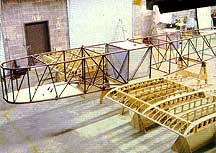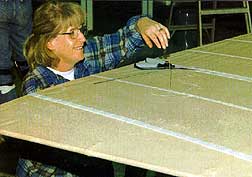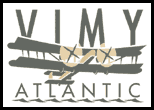Building the Vimy:
Part III: It All Comes Together
by Miles McCallum
On top of all that original creation, the target deadline
was 12 months from the start of construction. Peter was
determined to re-create one of the great Vimy record setting
flights — England to Australia — on the 75th anniversary
of that flight. Romantics have a thing about anniversaries...
By June, the forward fuselage and PSRUs were completed
in Australia. By then, sponsorship and assistance (some
of it the sort that no amount of money can buy) started
coming in from diverse sources such as the RAF museum
and Brooklands on one hand, and Stanford University on
the other.
 Component
pieces came together fairly rapidly. All spars completed
by July. Lower wings at the end of August. The center
section a month later. By the time the rear fuselage was
complete and shipped from Australia in October, the wings
were complete. In November, the tail was completed, testing
started on the engines and PSRU gearboxes, and National
Geographic was signed as major sponsor for the Australian
flight. Component
pieces came together fairly rapidly. All spars completed
by July. Lower wings at the end of August. The center
section a month later. By the time the rear fuselage was
complete and shipped from Australia in October, the wings
were complete. In November, the tail was completed, testing
started on the engines and PSRU gearboxes, and National
Geographic was signed as major sponsor for the Australian
flight.
In the interests of an accurate finish as possible, it
was decided to cover the aeroplane exactly as it had been
74 years before, using grade A cotton. With a thread count
of about 90/inch as opposed to 50-odd/inch, the difference
is instantly recognisable to those with an eye for historical
accuracy. In addition, they decided to apply the dope
by brush. This leaves a characteristic signature to the
finish, as well as being a lot less hassle to apply.
In December '93, the master fabric team from AJD Engineering
in the UK came over for 10 days to instruct the American
fabric crew in the use of natural fabrics — there is little
experience of cotton or linen in the USA.
The tally of covering materials left even John amazed.
"Five hundred yards! [of aircraft quality Grade A cotton]
WOW!" Coming in 5ft wide, 100yd bolts, it had to be sewn
into blankets for various components. The wing center
section, for instance, took five x 22ft long pieces sewn
edge to edge. Giant "rotisseries" had to be constructed
to handle the outsized pieces. The fabric was draped over
each piece, trimmed, and glued at the edges before being
shrunk with distilled water. Final tautening was accomplished
using Nitrocellulose dope as per the original.
 Rib
stitching was the last great dreary task. Over 10,000
knots had to be tied in total and the first wing panel
— needing about 1000 knots — took several days. With practice,
that came down to 12 hours a panel with three or four
people, at the rate of three hours per rib of 84 knots. Rib
stitching was the last great dreary task. Over 10,000
knots had to be tied in total and the first wing panel
— needing about 1000 knots — took several days. With practice,
that came down to 12 hours a panel with three or four
people, at the rate of three hours per rib of 84 knots.
The surface tapes, covering the rib stitching and reinforcing
critical areas, had to be right. Modern surface tapes
usually have a pinked (zig-zag) edge, whereas in 1919,
they used frayed tapes. These are made by ripping cotton
into strips, and stripping a couple of the warp threads
from the edges, leaving the characteristic frayed edge.
In effect, they work exactly like pinked edges. Nearly
a mile of tapes were ripped, frayed, ironed and hung over
several weeks, before being doped on, followed by a further
three coats of Nitrocellulose.
In the interests of safety, being much less incendiary,
the two silver (ultraviolet barrier) and green finishing
coats of dope were Butyrate. The colour of the finish
coats was matched to a piece of the original fabric from
G-EAOU — the entire left aft fuselage cover. The covering
job took four months alone.
Rigging the wings for the first time proved to be a case
of making it up as they went along. Rather than assemble
it as Vickers did 75 years before — by starting with the
lower center section and working up — they completed the
lower panels, and then fitted the top wing, including
ailerons, in one go. This presents something of a problem
when you are dealing with a flimsy 68ft structure weighing
1000lb needing to be accurately positioned 16ft up. The
strength is developed once it has been tied into a rigid
box structure with the rigging wires.
The components were moved to a huge hangar in Hamilton
Airforce base at Novoto, California, and a giant truss
built to support the top wing while it was hoisted into
position. Bracing wires were provided by Bruntons of Musselburgh,
the Scots company that had provided the wires for the
original Vimy.
This time, in the interests of better safety margins,
the flying wires (those that go up and outboard) were
doubled up. No one had any experience of such a large
biplane, and a fair amount of trial and error was required
to complete the job.
© Miles McCallum 1997, 1998.
Photos by Matthew Rebholz show the Vimy under construction.
| 

